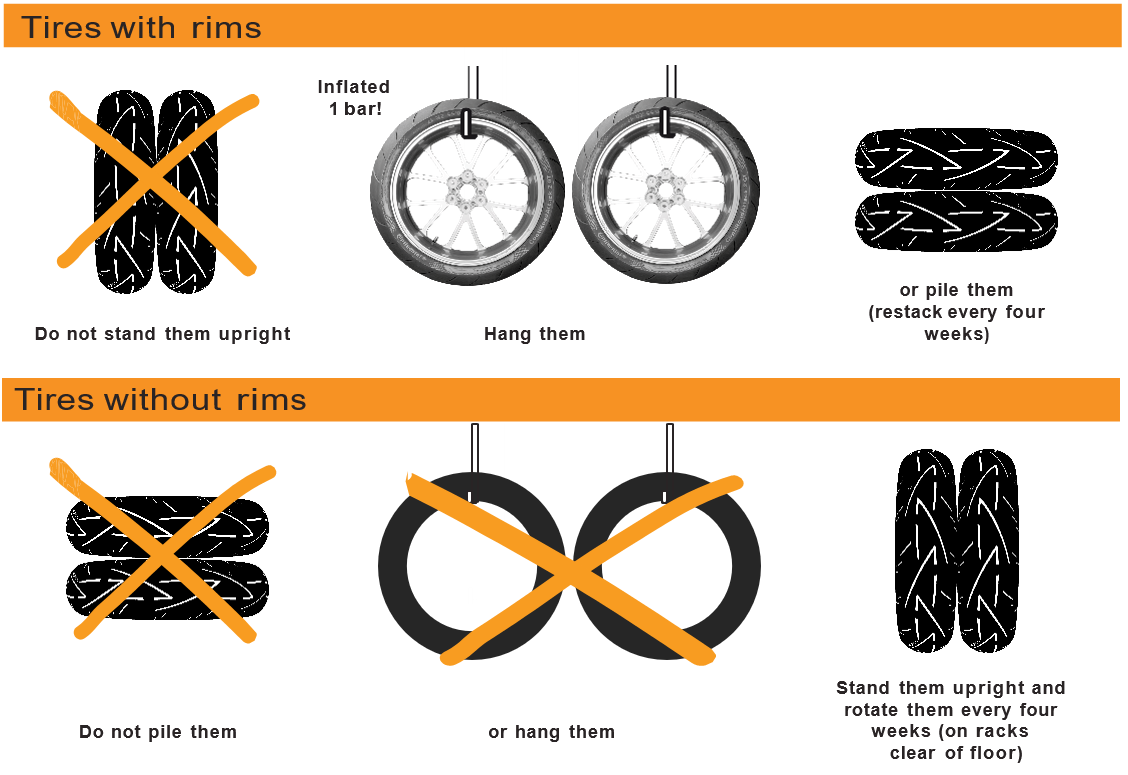Visit Continental Tires in your country for local vehicle fitment
# Tire Knowledge
Tire Storage Recommendations
for Motorcycle & Scooter Tires
Tire compounds are formulated to resist deterioration caused e.g. by sunlight, humidity and ozone. Nevertheless, stored tires should be protected against these and other potentially damaging conditions. The longer the storage period, the more exposure there is to potential damage.

Do's and Don'ts
- DO store tires where it is clean, dark, dry and moderately ventilated. Moist conditions should be avoided. Tires destined for retreading/repairing should be thoroughly cleaned and dried out before such operations are performed.
- DO store tires whitewall-to-whitewall to avoid staining.
- DO store tires, if outdoors, protected by an opaque waterproof covering, but avoid creating a heat box or steam bath. Ensure proper ventilation.
- DO store tires, if outdoors, where tires are raised off the storage surface.
- AVOID storing tires where the area is wet, oily, and/or greasy such as with gasoline or petroleum-based products.
- AVOID storing tires on piers, ship decks, or other unprotected areas.
- AVOID storing tires where subject to extreme temperatures direct sunlight or artificial light with a high ultra-violet content. Room lighting with ordinary incandescent lamps is preferable to fluorescent tubes.
- AVOID storing tires on black asphalt or other heat absorbent surfaces.
- AVOID storing tires adjacent to highly reflective surfaces (i.e., sand or snow-covered ground).
- AVOID storing tires in the same area as an electric motor or other ozone generating source. If there is a question, check ozone levels to be sure they do not exceed 0.08 ppm.
- AVOID storing tires in the proximity of chemical agents like solvents, fuels, oils, hydrocarbons, paint, acids, disinfectants, etc.
- DO NOT use tires as a workbench or tool stand. Soldering irons, power drill and tools can damage a tire.
- DO NOT store other items on top of a tire, especially where staining of the surface would be a concern.
- NEVER store them near battery chargers, ovens or open fires.
- NEVER put a burning cigarette on a pile of tires.
Storage Temperatures
- DO store all motorcycle tires at temperatures not exceeding 35°C / 95°F, preferably below 25°C / 77°F.
- AVOID storing conventional motorcycle tires (Sport/Touring/Off-Road/etc.) at temperatures well below the freezing point (max. -20°C / -4°F).
- AVOID storing race motorcycle tires (Track/RaceAttack) below 0°C / 32° F.
- ALWAYS allow tires - which have been exposed to 0°C / 32°F or less - to warm to room temperature (approx. 20°C / 70° F) for a minimum of 24 hours before the tires are mounted or flexed.
- NEVER take motorcycle tires below the above-mentioned storage temperatures for race and conventional tires into service, otherwise it may lead to cracks in compound and/or structure of the tires!
Storage Options
- Store tires so that tires retain their shape.
- Mounted tires should preferable be inflated to only 100 kPa (15 psi).
- Be sure to adjust the tires to the recommended inflation pressure before mounting on the vehicle.
Preferred positions are shown below:

Tires installed on a vehicle in long term storage
If possible, store the vehicle on the main stand or on a motorcycle jack to remove all weight from the tires and cover the tires to protect them from environmental exposure.
If the vehicle cannot be lifted from the storage surface, completely unload the vehicle, so minimum weight will rest on the tires. The storage surface should be firm, reasonably level, well drained and clean.
In cases where the tires will be supporting the vehicle, it is permissible to inflate the tires to the maximum pressure listed on the sidewall. Be sure to return the inflation pressure to recommended usage pressure before operating the vehicle.
In cases where the tires will be supporting the vehicle, it is recommended that the vehicle be moved every month to minimize ozone cracking in the contact area and also to minimize a "flat spot" from developing. If the tires do develop "flat spots," they will usually disappear in a short period of service.